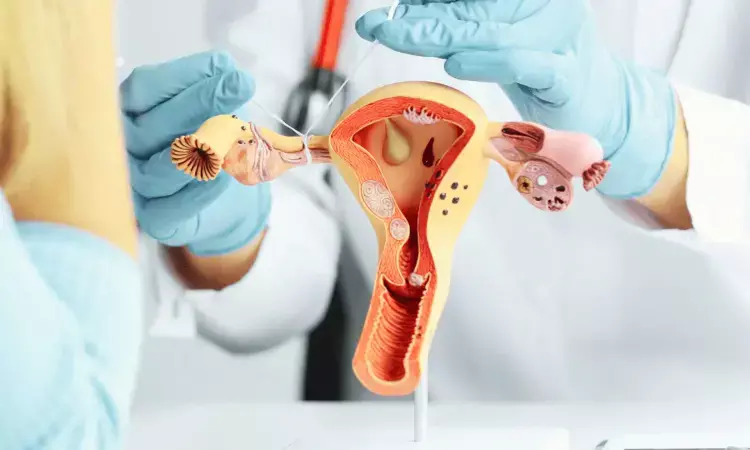- Home
- Medical news & Guidelines
- Anesthesiology
- Cardiology and CTVS
- Critical Care
- Dentistry
- Dermatology
- Diabetes and Endocrinology
- ENT
- Gastroenterology
- Medicine
- Nephrology
- Neurology
- Obstretics-Gynaecology
- Oncology
- Ophthalmology
- Orthopaedics
- Pediatrics-Neonatology
- Psychiatry
- Pulmonology
- Radiology
- Surgery
- Urology
- Laboratory Medicine
- Diet
- Nursing
- Paramedical
- Physiotherapy
- Health news
- Fact Check
- Bone Health Fact Check
- Brain Health Fact Check
- Cancer Related Fact Check
- Child Care Fact Check
- Dental and oral health fact check
- Diabetes and metabolic health fact check
- Diet and Nutrition Fact Check
- Eye and ENT Care Fact Check
- Fitness fact check
- Gut health fact check
- Heart health fact check
- Kidney health fact check
- Medical education fact check
- Men's health fact check
- Respiratory fact check
- Skin and hair care fact check
- Vaccine and Immunization fact check
- Women's health fact check
- AYUSH
- State News
- Andaman and Nicobar Islands
- Andhra Pradesh
- Arunachal Pradesh
- Assam
- Bihar
- Chandigarh
- Chattisgarh
- Dadra and Nagar Haveli
- Daman and Diu
- Delhi
- Goa
- Gujarat
- Haryana
- Himachal Pradesh
- Jammu & Kashmir
- Jharkhand
- Karnataka
- Kerala
- Ladakh
- Lakshadweep
- Madhya Pradesh
- Maharashtra
- Manipur
- Meghalaya
- Mizoram
- Nagaland
- Odisha
- Puducherry
- Punjab
- Rajasthan
- Sikkim
- Tamil Nadu
- Telangana
- Tripura
- Uttar Pradesh
- Uttrakhand
- West Bengal
- Medical Education
- Industry
Pregnancy Rates After Tubal Sterilization: New Data Shows More Cases Than Expected

USA: A new study analyzing data from the United States between 2002 and 2015 has revealed that pregnancies following tubal sterilization may be more common than previously understood.
"Following tubal sterilization, 2.9% to 5.2% of women reported becoming pregnant in four separate survey waves. In the latest survey period (2013-2015), the estimated failure rate at one year was 2.9%, while the failure rate at ten years was 8.4%," the researchers reported in NEJM Evidence.
Tubal sterilization, a popular form of permanent contraception, is designed to prevent pregnancy by blocking or sealing the fallopian tubes. It is generally considered a highly effective method of contraception, with a success rate exceeding 99%. Tubal sterilization is the most prevalent form of contraception in the United States.
Given that the effectiveness of contraceptive methods affects their choice, Eleanor Bimla Schwarz, Division of General Internal Medicine, Department of Medicine, University of California, San Francisco, San Francisco, and colleagues investigated the typical use failure rates of tubal sterilization in the U.S.
For this purpose, the researchers estimated pregnancy rates following tubal sterilization by analyzing data from four waves of the National Survey of Family Growth (NSFG). This data, collected from representative samples of U.S. women aged 15 to 44 years in 2002, 2006 to 2010, 2011 to 2013, and 2013 to 2015, was used to assess the time to first pregnancy after tubal sterilization.
The researchers employed survey weighting in survival analysis to account for various factors and censored data from participants who underwent tubal reversal, infertility treatments, hysterectomy, or bilateral oophorectomy. Kaplan–Meier curves and multivariable Cox proportional-hazards models were used to examine pregnancy rates, considering variables such as age at sterilization, race/ethnicity, education, Medicaid funding, and whether the procedure was performed postpartum or at another time.
The following were the key findings of the study:
- 2.9 to 5.2% of participants reported pregnancy after tubal sterilization across NSFG waves.
- In the most recent survey wave (2013 to 2015), the estimated percentage of participants with pregnancies within the first 12 months after a tubal sterilization procedure was 2.9%; at 120 months after tubal sterilization, the estimated percentage with pregnancy was 8.4%.
- At all the time points examined, pregnancy after tubal sterilization was less common after postpartum procedures than after interval procedures; however, this difference was not evident in multivariable models.
- In multivariable models, the chance of pregnancy decreased with age at the time of tubal sterilization.
- Race/ethnicity, education, and Medicaid funding were not consistently associated with pregnancy after tubal sterilization.
"These data indicate that pregnancy rates after tubal sterilization may be higher than previously anticipated," the researchers concluded.
Reference:
Schwarz EB, et al "Pregnancy after tubal sterilization in the United States, 2002 to 2015" NEJM Evid 2024; DOI: 10.1056/EVIDoa2400023.
Dr Kamal Kant Kohli-MBBS, DTCD- a chest specialist with more than 30 years of practice and a flair for writing clinical articles, Dr Kamal Kant Kohli joined Medical Dialogues as a Chief Editor of Medical News. Besides writing articles, as an editor, he proofreads and verifies all the medical content published on Medical Dialogues including those coming from journals, studies,medical conferences,guidelines etc. Email: drkohli@medicaldialogues.in. Contact no. 011-43720751


